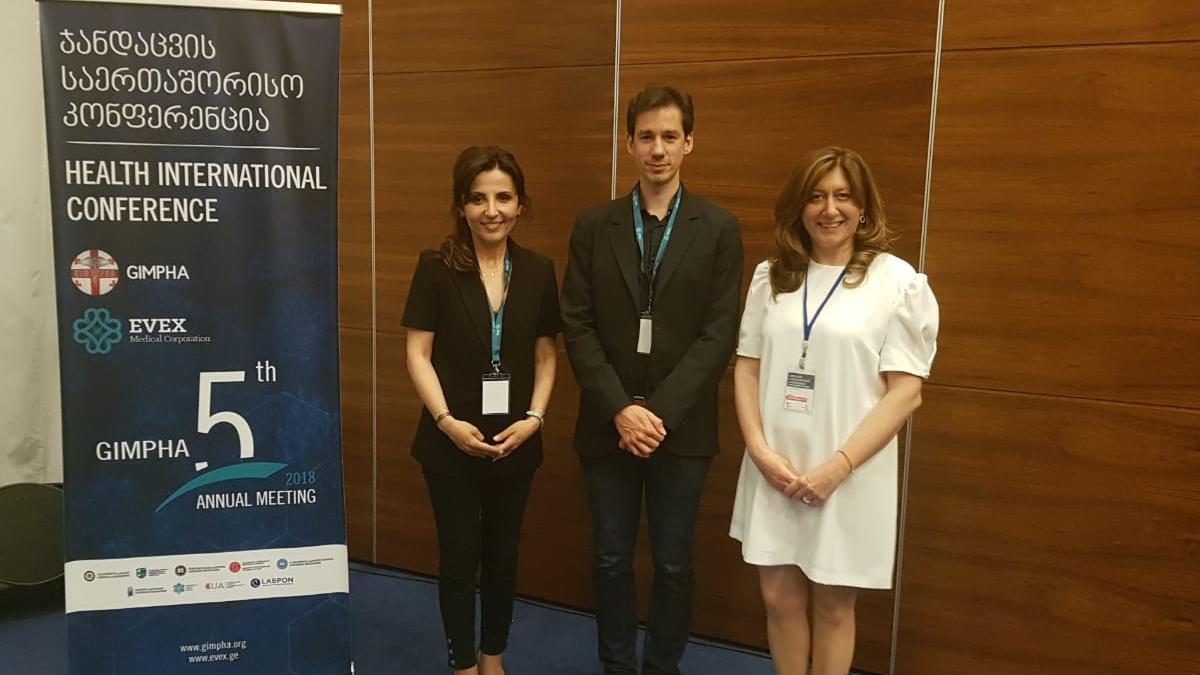Members • Sectors & markets
Centre Kakhetie-Yonne - 5th Health International Conference
French doctors sharing their expertises on "infectious deceases" at the Forum in Tbilisi.
Centre Kakhetie-Yonne
5th Health International Conference
On May 19th and 20th, 2018 took place the 5th Health International Conference. Our member Nargizi Zibzibadze from the medical center Kakhetie-Yonne pronounced the inauguration speech.
Among the speakers were three French doctors that took part in the session "infectious deceases": Dr. Sylvain Diamantis, Dr. Laurence Slama et Dr Eka Chakvetadze.
They shared the French experience in the struggle against bacterial resistance that is affecting in particular Georgia.
They undertook a collaboration with the medical center Kakhetie-Yonne and they will present their research at the National Day of Infectious Decease in Nantes (France), in June.
Epidemology of the community's bacterial resistance of enterobacteriaceae isolated from CBEU (cytobacteriological examination of urine) realised in a Georgian medical center.
Researchs were led by:
Catherine Chakvetadze- Service de maladies infectieuses, CH Sud Ile de France, Melun
Alessio Strazzulla - Service de maladies infectieuses, CH Sud Ile de France, Melun
Sophiko Zirakashvili - Centre médical « Kakhétie-Yonne », Géorgie
Narguiz Zibzibadze - Centre médical « Kakhétie-Yonne », Géorgie
Aurélia Pitsch - Laboratoire de biologie médicale, CH Sud Ile de France, Melun
Introduction
There is an important migratory flow from the countries of the former Soviet-Union, like Georgia, where the bacterial multiresistance including the tuberculosis is noteworthy. Nevertheless no epidemologic data on bacterial resistance in the community are currently available in Georgia.
Materials and Methodology
Descritpion of the enterobacteriaceae resistance from the whole antibiograms realised by the system Liofilchem, Urin system plus on CBEU, completed between January 2016 and December 2017 in a medical center in the South-West of Georgia.
Results
Within the 302 cytobacteriological examination of urine (CBEU), 130 enterobacteriaceae have been isolated.
The deduplication has been realised under the criteria of ONERBA (French National Observatory for Epidemiology of Bacterial Resistance to Antimicrobials).
Among the 130 enterobacteriaceae:
- E.Colis has been isolated in 79 CBEU
- Proteus spp. in 13 CBEU
- Enterobacteriaceae from the group KES in 18 CBEU
- The other CBEU were polymicrobia with E.colis + KES (n=18) or E.colis + Proteus spp. (n=2).
The resistance rate of the E.coli:
- to the cefotaxime was of 20% (16)
- to the ceftazidime of 28% (22)
- to the nalidixic acid of 37% (29)
- to the cotrimoxazole of 66% (52)
Table 1: Resistance rate of the E.colis and of all the enterobacteriaceae [n(%)].
Within the whole enterobacteriaceae:
- 22% (28) were resistant to cefotaxime,
- 28% (37) to the ceftazidime
- 39% (51) to nalidixic acid
- 66% (86) to cotrimoxazole
A particulary high resistance rate is also recorded for the aminoglycosides, with a resistance to:
- the amikacin for 39% (31) of the E.coli and
- 38% of the enterobacteriaceae and
a resistance of the gentamycine in:
- 30% (24) of the E.coli and
- 26% (34) of the enterobacteriaceae
Figure 1: Resistance percentage of E.coli in 2016 and 2017
The resistance of the phenotypes observed are different from the ones noticed in Western Europe with a preferential hydrolysis to ceftazidime on the cefotaxime and on the amoxicillin more than on the gentamycin.
A stem cell of E.coli was resistant to the integrality of the antibiotics tested (carbapenems and colimycine were not tested)
Conclusion
The resistance rate of the enterobacteriaceae observed in this study are by far superior to the one noticed in France but equivalent to the data examined in Grece. These results are reminding the necessity of an epidemiologic observation of bacterial resistance in different countries and of an international collaboration to take care of patients coming from Eastern Europe in order to restrain the phenomenon and to fight back with efficiency against its expansion.





